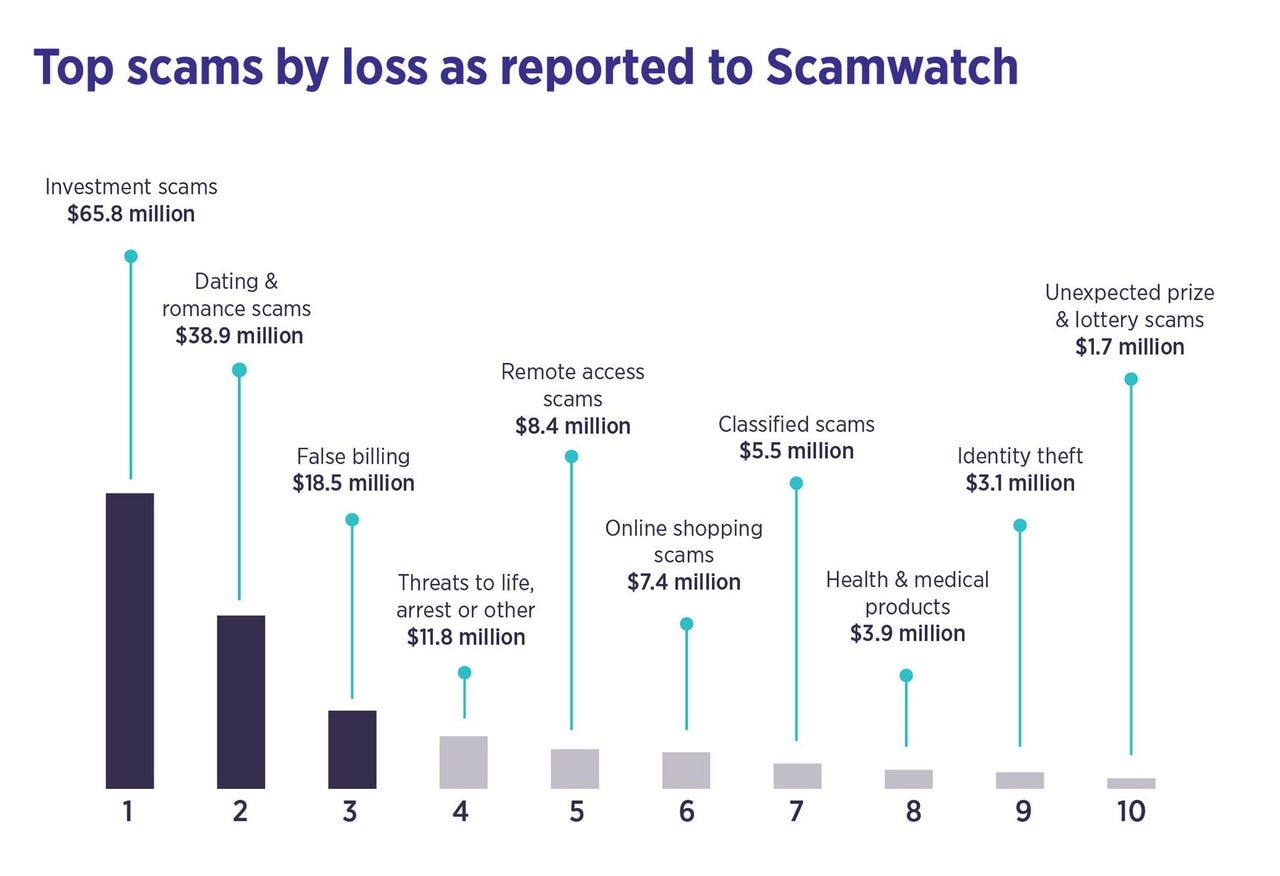Australians spent AU$26.5m in cryptocurrency to pay scammers in 2020

Australians in 2020 reported losses to scams totalled AU$851 million, with AU$128 million lost to business email compromise (BEC), AU$8.4 million classed as remote access scams, and AU$3.1 million a result of identity theft.
Topping the list of scams was investment scams, ripping people off to the tune of AU$328 million. The total number of scam incidents was 444,164.
The information was revealed in a report [PDF] from the Australian Competition and Consumer Commission's (ACCC) Scamwatch. The AU$851 million loss figure is reduced to AU$156 million, however, when information from Australia's top financial institutions is removed. This is still an increase of around 23% compared to the AU$143 million in losses reported in 2019.
The total number of scams received by Scamwatch during the 2020 calendar year was 216,087.
Bank transfer remained the most common payment method used in scams, with just over AU$97 million lost, but bitcoin and other cryptocurrency was the second highest payment method, with AU$26.5 million lost.
Those aged over 65 were the ones reporting the most loss, comprising AU$37.7 million of the total, but those in the 25 to 34-year old bracket made the most reports to Scamwatch, with 33,000 reports. The scam victims were almost split exactly 50-50 among those that identified as men and those that identified as women.
It was shown phone calls were still the number one method for scammers to use, at 47.7%, or 103,153 scams, with email accounting for 22%, text message for 15%, "internet" for 6.3%, and 4.5% of victims were spoofed via social media.
Unsurprisingly, COVID-19 led to an increase in losses and reports for several categories. Victoria, which was the hardest hit with lockdowns, was the origin of AU$49 million of the total losses for 2020.

Compared with 2019, remote access scam reported losses increased more than 74% to AU$8.4 million and threat-based scam reported losses increased more than 178% to AU$11.8 million. 8,691 scams were attributed to "hacking", 3,885 to ransomware and malware, and phishing accounted for 44,079 reports.
The most commonly impersonated entities for phishing scams in 2020 were the same as those in 2019: Telstra, NBN Co, government organisations, the big four banks, and package delivery companies, with a large increase in the number of phishing scams involving impersonations of Amazon.
Email phishing in 2020 most commonly impersonated PayPal, followed by Netflix.
Health and medical scam reported losses increased more than 2,000% compared with 2019 as a result of the pandemic, reaching over AU$3.9 million.
In 2020, there were over 24,000 reports about government impersonation scams made to the ACCC, with losses of AU$1.9 million.
There was also a 220% increase in reports and a 322% increase in reported losses to scams related to buying vehicles including cars, caravans, and campervans, with reported losses of just over AU$1 million. The ACCC said scammers targeted both people buying and selling vehicles and used Facebook Marketplace, Gumtree, Car Sales, and Autotrader, mostly, to make contact with potential victims.
Scamwatch also received over 330 bushfire-related Scamwatch reports through its website.
Celebrity endorsement scams caused reported losses of over AU$1.8 million in 2020. Some of these, the ACCC said, included encouraging people to invest in cryptocurrencies.
Scamwatch received 2,082 reports with reported losses of over AU$7 million to Chinese authority scams in 2020. This was a 77% increase in the number of reports and a 250% increase in the amount reported lost compared with 2019.
Scam losses reported by businesses increased by 260% in 2020, to AU$18 million. Businesses made the most reports about false billing and phishing scams, with the scams typically involving a request for payment for a service or item that wasn't ordered or a scammer diverting money by impersonating the intended recipient of a payment.
In 2020, WhatsApp was added as an option in the reporting form. The ACCC received 347 reports selecting WhatsApp from the drop down menu. Scam reports listing the contact mode as social networking/online forum and identifying the platform as dating app Tinder increased from 73 in 2019 to 174 in 2020.
"This 138% increase in reporting was primarily in relation to romance scams, but also included investment scams where scammers encouraged victims to invest in cryptocurrencies," the reported added.